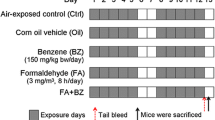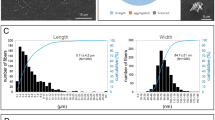Abstract
Because chronic benzene exposure is associated with acute myeloblastic leukemia and other myeloproliferative disorders, we sought to determine whether short-term benzene exposure provides a growth advantage for granulopoietic elements over erythropoietic elements. Groups of male DBA/2J mice were exposed to 0, 10, 30, or 100 ppm benzene (6 h/day for 5 days). One day and 5 days after the benzene exposures, the numbers of the two most primitive erythroid progenitor cells (BFU-E and CFU-E) and the numbers of the most primitive granulocytic progenitor cells (GM-CFU-C) were assessed. Additional groups of mice were given hemolytic doses of phenylhydrazine (PHZ) during the 5 days of benzene exposure, while other groups of mice were given PHZ during the 5 days of recovery from benzene exposure. These experiments were designed to determine the effects of benzene exposure on progenitor cell numbers during periods of markedly heightened erythropoiesis. The results demonstrate that short-term benzene exposure does induce a growth advantage for granulocytic cells in both the bone marrow and spleen of exposed mice. Moreover, a benzene-induced shift toward granulopoiesis is observed even in those mice treated with a powerful erythropoietic stimulus. These effects disappear 5 days after cessation of benzene exposure in the bone marrow but persist in the spleen of mice treated with phenylhydrazine.
Similar content being viewed by others
References
Aksoy M (1988) Benzene hematotoxicity and benzene carcinogenicity. In: Aksoy M (ed) Benzene carcinogenicity, CRC Press, Boca Raton, pp 59–151
Baarson K, Snyder CA, Albert R (1984) Repeated exposures of C57B1 mice to 10 ppm inhaled benzene markedly depressed erythropoietic colony formation. Toxicol Lett 20: 492–503
Broxmeyer H (1978) Inhibition in vivo of mouse granulopoiesis by cell free activity derived from human polymorphonuclear neutrophils. Blood 51 (5): 889–901
Dempster A, Snyder CA (1989) The ability of the murine erythron to respond to hemolytic doses of phenylhydrazine is significantly impaired by exposures to 10 ppm benzene. Toxicol Lett 48: 249–256
Drew R, Laskin S (1973) Environmental inhalation chambers. In: Gay W (ed) Methods of animal experimentation, vol 4. Academic Press. New York, pp 1–41
Green J, Snyder CA, LoBue J, Goldstein B, Albert R (1981) Acute and chronic dose/response effects of inhaled benzene on multipotential hematopoietic stem (CFU-S) and granulocytic/macrophage progenitor (GM-CFU-C) cells in CD-1 mice. Toxicol Appl Pharmacol 58: 492–503
Keller K, Snyder CA (1986) Mice exposed in utero to low concentrations of benzene exhibit enduring changes in their colony forming hematopoietic cells Toxicology 42: 171–181
McLeod D, Shreeve M, Axelrod A (1974) Improved plasma culture system for production of erythrocytic colonies in vitro: quantitative assay method for CFU-E. Blood 44: 517–534
Metcalf D, Johnson G (1978) Production by spleen and lymph node cells of conditioned medium with erythroid and other hemopoietic colony-stimulating activity. J Cell Physiol 96: 31–42
Snyder CA (1987) Benzene. In: Snyder R (ed) Ethel Browning's toxicity and metabolism of industrial solvents, second edition. Elsevier. Amsterdam, New York, pp 3–37
Snyder CA, Magar K (1983) A single feed system for maintaining different vapor concentrations in two inhalation chambers. Am Ind Hyg Assoc J 44 (3): 234–236
Weinberg S (1981) Fetal murine hemopoiesis following in utero low dose radiation. J Embryol Exp Morph 62: 37–46
Zar J (1984) Biostatistic analysis, 2nd edn., Prentice-Hall, New Jersey
Author information
Authors and Affiliations
Rights and permissions
About this article
Cite this article
Dempster, A.M., Snyder, C.A. Short term benzene exposure provides a growth advantage for granulopoietic progenitor cells over erythroid progenitor cells. Arch Toxicol 64, 539–544 (1990). https://doi.org/10.1007/BF01971832
Received:
Revised:
Accepted:
Issue Date:
DOI: https://doi.org/10.1007/BF01971832




